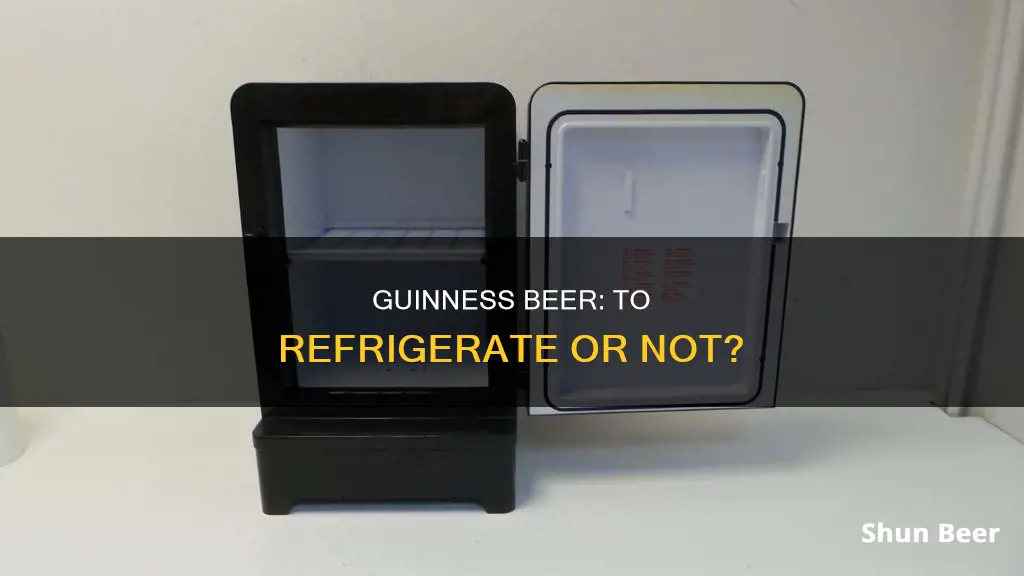
Storing Guinness beer at the optimal temperature is essential for preserving its distinct flavour and ensuring a perfect pour. While some beer enthusiasts advocate for storing Guinness at cellar temperature (around 50-55°F), which is cooler than average room temperature, others suggest that the draught product, including cans, should be served colder, in the lower 40°F range. Colder temperatures can subdue some of the flavours in beer, so it is recommended to let the beer warm up for a few minutes after taking it out of the fridge to enjoy its full flavour. Additionally, the serving technique can impact the beer's head and overall taste, with some recommending turning the can upside down immediately after opening to achieve the desired surge and creamy head.
What You'll Learn

Draught Guinness cans have a nitro widget to simulate the tap pour
Draught Guinness cans contain a nitro widget, a tiny plastic ball, that simulates the tap pour. The widget was developed by Guinness in 1969 to give their canned brews a silky, creamy head. During the canning process, brewers add liquid nitrogen to the beer immediately before sealing it. The liquid nitrogen quickly evaporates, creating pressure inside the can. This forces gas and liquid into the widget through its tiny hole. Then, when you open the can, you should hear a "pssshhh" sound. That's the gas and liquid leaving the widget, which mixes with the beer, creating a foamy head. This process gives canned Guinness the same texture and taste as a freshly poured draught Guinness.
The nitro widget is specifically designed to enhance the taste and texture of Guinness draught beer. It is important to note that Guinness Extra, which is sold in bottles, does not contain the widget and is a different product from Guinness Draught. The widget in the draught cans simulates the pouring of a Guinness tap, creating a rich, creamy head. This technology ensures that the beer has the iconic Guinness two-part pour, with perfectly formed nitrogen bubbles, resulting in a smooth and flavourful taste.
The widget also helps to address the issue of nitrogen gas in liquid being fleeting. By slowly releasing nitrogen into the beer upon opening, the widget maintains the desired levels of gas in the packaged beer. This innovation has been so successful that other beers, such as Young's Double Chocolate Stout, Murphy's Stout, and Boddingtons Pub Ale, have also started using widgets in their cans.
To get the best experience from a Draught Guinness can with a nitro widget, it is recommended to follow the specific instructions on the can. Nitro-cans should be cooled in the fridge and opened while cold. Opening a nitro-can at room temperature can result in a mess as the nitrogen comes out of solution quickly. Additionally, it is recommended to pour the beer into a glass after opening the can to fully appreciate the smooth, creamy head created by the widget.
In conclusion, the nitro widget in Draught Guinness cans is a clever innovation that simulates the tap pour, ensuring that consumers can enjoy the iconic taste and texture of Guinness at home. By mimicking the draught pouring experience, the widget enhances the overall Guinness drinking experience, making it more accessible and convenient for beer lovers.
Guinness Beer Ingredients: A Magical Brew's Secret
You may want to see also

Colder temperatures can subdue flavours in Guinness
Colder temperatures can indeed subdue flavours in Guinness. In fact, Guinness itself recommends that draught Guinness should be served at 6-7 °C (42.8 °F), while Extra Cold Guinness should be served at 3.5 °C (38.6 °F).
The ideal serving temperature for Guinness has been a topic of debate for many years. Some people prefer their Guinness colder, while others prefer it warmer. Some sources claim that Guinness should be served at room temperature, or slightly chilled, as serving it extra cold can take away its characteristic flavour.
Guinness is a stout with a rich, dark flavour derived from malted barley and roasted unmalted barley. The ideal serving temperature aims to highlight these flavours without subduing them. Serving Guinness at colder temperatures can reduce the formation of the ideal head and affect the taste.
It is worth noting that the serving temperature can also depend on the variant of Guinness being consumed. For example, Guinness Foreign Extra Stout is served at a higher temperature of around 16-18 °C to showcase its strong taste. Ultimately, the ideal serving temperature for Guinness may come down to personal preference, with some people enjoying it colder and others preferring it warmer.
The Evolution of Guinness Beer: A Historical Perspective
You may want to see also

Bottles/cans are treated differently post-brewery and age faster
Bottles and cans of beer are treated differently post-brewery and age faster. This is because bottles and cans are almost always stored warm. Even if they are displayed in a cold case at the store, they were probably warehoused warm until the store stocked their cold case. The warm temperature makes bottles and cans age faster. In contrast, kegs are almost always stored cold, allowing them to retain their original flavour for longer.
The type of container you use can also affect the taste of your beer. Crusaders for cans argue that light leaking through transparent bottles causes beer's chemical compounds to decompose faster, resulting in a "skunky" aroma or an unpleasant taste. This is known as "lightstrike". On the other hand, bottle boosters claim that cans leave a tinny taste and are too sensitive to temperature changes. However, brewers started lining beer cans with food-safe plastic in the 1930s to prevent metallic tastes, and brown bottles provide better protection against lightstrike than clear or green bottles. Ultimately, the best way to enjoy beer is to pour it into a glass, as this provides the full sensory experience and allows you to appreciate the colour, aroma, and texture of the beer.
Guinness Beer Mixology: Creative Concoctions for a Unique Taste
You may want to see also

Nitro-cans have specific instructions about cooling and opening
Nitro-cans are a unique way to enjoy Guinness beer. They are designed to mimic the experience of drinking Guinness on draught, with a creamy draught-style head. To get the best experience from your Guinness nitro-can, it's important to follow the specific instructions for cooling and opening.
Firstly, it is recommended to refrigerate your nitro-cans for at least 24 hours before consumption. This ensures that the beer inside reaches the optimum temperature and taste profile. A cold temperature is crucial for the iconic two-part pour that Guinness is famous for.
When you're ready to enjoy your Guinness, it's important to keep the can cold until you're ready to open it. Opening a nitro-can at room temperature can result in a mess, as the nitrogen comes out of solution more quickly. So, keep your can refrigerated until the last moment before opening.
The opening process for a nitro-can is also important. Start by slowly opening the can, then aligning the nozzle of the Nitrosurge device with the can opening. Push the device firmly into place, ensuring a tight seal. Once the device is secure, you can activate it by pressing the power button. The Guinness Harp symbol will illuminate, indicating that the device is ready for use.
With the device activated, you can now begin pouring your Guinness. Hold your glass at a 45-degree angle and bring the can to a horizontal position. As you pour, gradually rotate the can and glass together until the can is also at a 45-degree angle and the glass is vertical. Stop pouring when the glass is about three-quarters full.
Allow the beer to settle for about 60 seconds. This is when the iconic surge and settle of the two-part pour happens. Finally, without lifting the glass, angle the nitro-can once again at 45 degrees and slowly top up the glass to form the classic Guinness domed head. Now you can sit back, relax, and enjoy the perfect pint of Guinness, crafted with precision and technology.
Guinness Beer: Fattening or Healthy Drink?
You may want to see also

Glass cleanliness is important for a good head
Glass cleanliness is of utmost importance for a good head on your Guinness. Even if your glass appears clean, there may still be residual oils, sugars, or detergent clinging to the inside of the glass, which can ruin your beer-drinking experience. This is especially true if the glass has been used for other beverages, such as milk or soda, or has been washed with a detergent that hasn't been thoroughly rinsed off.
To ensure your glass is "beer clean", it's important to dedicate specific glasses solely for beer. This prevents the transfer of oils and sugars from other drinks, which can cause head retention problems and affect the aroma of your beer.
When cleaning beer glasses, it's best to use a good glassware detergent or a small amount of baking soda or salt. Commercially, Barkeeper's Friend is a good option as it uses oxalic acid and is effective at cleaning stainless steel without harming the glass. After washing, it's crucial to thoroughly rinse the glass with clean water to ensure all detergent is removed.
In commercial settings, such as bars, bartenders should frequently change their rinse water to ensure the glasses are properly cleaned. Additionally, they should choose the right sanitizer, being careful not to use too much, as it can leave a residue that affects the aroma and flavour of the beer.
A good practice is to rinse the glass with clean, cold water just before pouring the beer. This helps eliminate any residual detergent or dust that may have settled in the glass since it was last washed.
By following these simple steps, you can ensure your glass is "beer clean" and enjoy your Guinness with a nice, creamy head.
Guinness Beer vs. World Records: What's the Difference?
You may want to see also
Frequently asked questions
Guinness beer is best served at a temperature of 50-55 degrees Fahrenheit. Lager is better served at a temperature of 42-46 degrees Fahrenheit.
Guinness beer can be stored in a refrigerator or in a cool storeroom. It is recommended to be stored in a range of about 50-55 degrees Fahrenheit.
Guinness beer can be stored for up to a month if it is kept at a steady cool temperature. However, it is recommended to consume the beer within 30-45 days of purchase.
To pour a can of Guinness beer, open it on a flat surface and let it rest for about 6 seconds. Then, tilt the glass and begin to pour gently. It is important to ensure that the glass is clean and free of detergent residue to achieve a good head.







